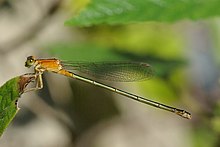Senegal pitch dragonfly
| Senegal pitch dragonfly | ||||||||||||
|---|---|---|---|---|---|---|---|---|---|---|---|---|

Senegal pitch dragonfly ( Ischnura senegalensis ), female with androchrome coloring |
||||||||||||
| Systematics | ||||||||||||
|
||||||||||||
| Scientific name | ||||||||||||
| Ischnura senegalensis | ||||||||||||
| ( Rambur , 1842) |
The Senegal pitch dragonfly ( Ischnura senegalensis ) is a dragonfly from the family of the slender dragonfly (Coenagrionidae).
features
The animals reach a body length of about 30 millimeters and a hind wing length of 14.5 to 15.5 millimeters. The male has a black, roughly metallic head on the upper side, the complex eyes are black above, blue-green below. The face is blue-green and black with fine white hairs (setae). The labrum is blue-green with a black base and a yellow border, the anteclypeus green or blue-green, the postclypeus shiny black, the frons green. The prothorax is black above, greenish below and on the collar, the synthorax black with a metallic sheen with a fine white pubescence, with a separate longitudinal stripe that is green to yellowish, rarely also blue. The clear wings have a two-tone wing mark, which is black in the inner half and bright blue in the outer half. On the abdomen, the segments are black up to the seventh on the upper side, on the second, less clearly also on the first, with a bright blue patch on the side that is connected on the underside. The eighth segment of the abdomen is highlighted in blue. The ninth and tenth segments are black above, blue and brownish below. The tenth segment has a raised, two-pointed extension on the rear edge. The upper appendages are small and triangular in side view, the lower ones are elongated and bent horn-shaped when viewed from above.
The females appear in two color morphs . They are either colored similarly to the males, or they are two-tone reddish and black. In both forms, the postclypeus and the top of the head are black with a metallic sheen, with a sharply defined light band in the front half of the fron.
The abdominal drawing of the species is similar to that of the European Ischnura elegans , but in Ischnura senegalensis the seventh abdomen segment on the ventral side (ventral) is not blue. Species of the genera Proischnura and Azuragrion can be drawn very similarly. The similar genus Agriocenemis can be distinguished by their much smaller body size.
Occurrence
The Senegal pitch dragonfly is found in the tropical and subtropical parts of the Old World . The distribution area extends from Africa via India and Sri Lanka to East Asia and north to Japan and southeast to West New Guinea . It inhabits different habitats in stagnant or slowly flowing waters. It is tolerant of human influences and water pollution; it is absent in areas with intact forest cover. It can survive in desert areas in drying pools in water with one and a half times the salt concentration of seawater. The species is not endangered.
The species is occasionally transported to Europe with water plants in aquariums, where it can complete its development and also hatch. In 2011, three animals hatched from an aquarium in Ulm.
Way of life
When laying eggs, the female is not accompanied by the male, as is the case with most other dragonfly species. Through this accompaniment, males of other species prevent strange males from approaching the female and ensure that the female can lay the eggs undisturbed in the reeds. How the disturbance of foreign males in the Senegal pitch dragonfly is avoided has not yet been researched. It is assumed, however, that the high proportion of androchrome females (between 21 and 67 percent) plays a role.
Individual evidence
- ↑ Michael J. Samways: Dragonflies and Damselflies of South Africa. Pensoft Publishers, 2008. ISBN 9546423300 . p. 98 Preview on Google Books
- ^ Frank Suhling, Reinhard Jödicke, Wolfgang Schneider (2003): Odonata of African arid regions - are there desert species? Cimbebasia 18: 207-224.
- ↑ Sharma, G. 2013. Ischnura senegalensis. In: IUCN 2014. IUCN Red List of Threatened Species. Version 2014.1.
- ↑ Theodor Benken & Martin Komander (2011): The Senegal pitch dragonfly (Ischnura senegalensis) hatches in an aquarium near Ulm. Mercuriale - Dragonflies in Baden-Württemberg Volume 11: 51-52.
- ↑ Yuma Takahashi & Mamoru Watanabe: Diurnal changes and frequency dependence in male mating preference for female morphs in the damselfly Ischnura senegalensis (Rambur) (Odonata: Coenagrionidae). Entomological Science, 12, 3, pp. 219-226, 2009
- ↑ Shoichi F. Sakagami, Hidenori Ubukata, Mikio Iga & Masanori J. Toda: Observations on the Behavior of Some Odonata in the Bonin Islands, with Considerations on the Evolution of Reproductive Behavior in Libellulidae. Journal of the Faculty of Science Hokkaido University, Series V, Zoology, 19, 3, pp. 722-757, 1974
Web links
- G. Sharma (2010): Ischnura senegalensis . In: IUCN 2011. IUCN Red List of Threatened Species, Version 2011.2. Retrieved January 10, 2012
